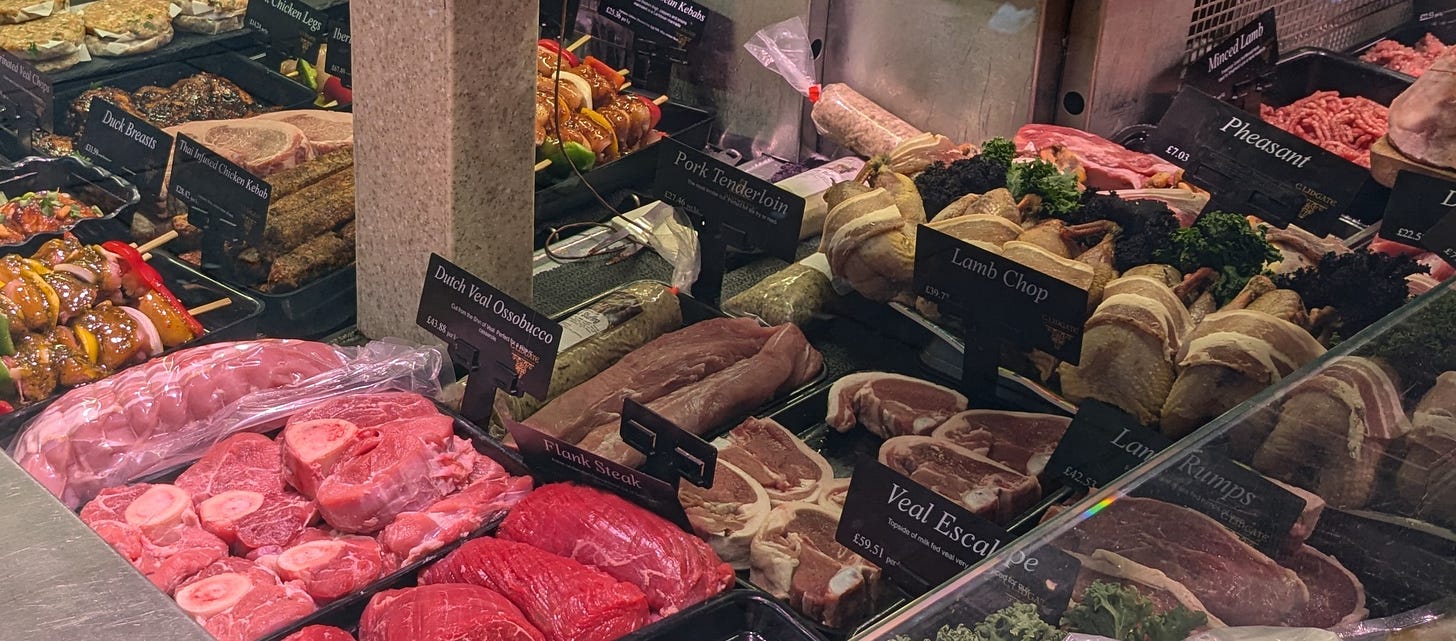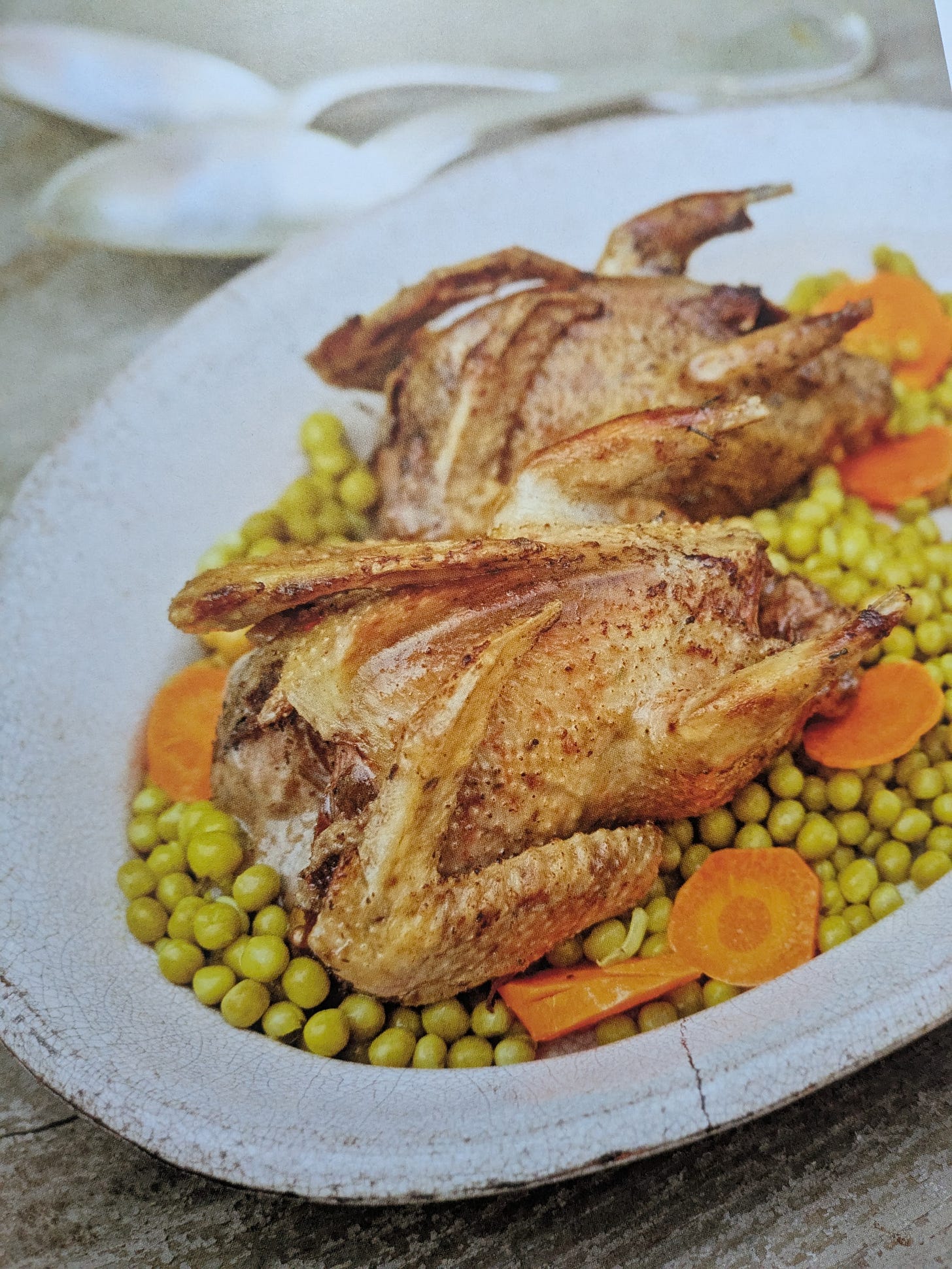Getting back to Washington DC from Europe after Labour Day, an act revealing my despair at the end of summer which didn’t reflect the slightest bit well on me, was to pay a visit to Whole Foods, our semi-high end supermarket chain. “Hello,” I’d merrily trill to the poor benighted individual manning the meat counter on the day I elected to visit. “May I have a grouse?” “We don’t do grouse.” “Not to worry. I’ll take a partridge.” “No partridge.” “Pheasant? Pigeon?” “Chicken. We have chicken.”
My catalogue of game was no more than was commonly available in any supermarket in France where I had spent the summer, in Britain and on the Continent in general.
We Europeans also tuck enthusiastically into all offal from liver to brains and testicles though despite her serving it up weekly, my grandmother was by far and away the worst cook of tripe in the galaxy: elastic bands in a pasty onion-flavoured sauce. Soon after my arrival in the US, I made the naive decision to represent British cuisine and introduce Kate-and-Sidney pie to some new connections. This was a business dinner, too soon to know if they would become friends and I felt we should represent Britain. (If you require light shedding on the name of the dish, just drop a note in Comments.) While finding the necessary stewing steak was not a challenge, sourcing the equally vital kidneys was a teaser. Eventually, I unearthed a French market where, if I was prepared to sign an FDA waiver form taking personal responsibility for any untoward reaction to them, the butcher would order me some frozen ones.
These days, the food scene in the centre of US capital is considerably more adventurous. (It’s always been adventurous in the suburbs where communities from Latin American, South East Asia and more cook and sell some of the best food you can eat in any capital.) But back then it was hard to imagine that those intrepid pioneers on the wagon trains travelling across gruelling terrain through challenging conditions would not have turned to every scrap of offal to feed themselves as their food supplies diminished. Surely snakes and vermin, too, trapped before these could scramble into the scrub to escape sacrifice, not to speak of any pilgrim pets. When did fear and revulsion for anything more than a recognisable pre-cut, pre-packed piece of bleeding vermilion flesh set in? Even lamb wasn’t received with much enthusiasm at the work-related dinners the posting required that I cook at least weekly. I hasten to say those nervous diners didn’t include adventurous DC friends from the hospitality industry, and neighbours who had travelled extensively overseas who ate everything that went to the table at our much more informal suppers.
But back to the pleasures of wild fowl at this time of year. I feel a great nostalgia for a game bird. My mother would roast them from the Glorious 12th (the August opening day of the British shooting season) and onwards until the poachers with a brace to sell stopped turning up on her doorstep. She would serve them with toasted buttered breadcrumbs, a jug of juices, and a bread sauce, that beige squelch which looks like a gum suitable for hanging wallpaper and revolts many a Brit. Not us. Once in Moscow I discovered – oh, magnificent occasion! You’ve no idea how wonderful! – a frozen duck in the Polish store. It had been shot, then tossed as it was, beak and feet and guts and all, straight into a freezer, fully feathered. The lead still peppered its breast. I rushed it home, rigid with ice as it was, to treat as my mother might have done. Take it from me, it’s a challenge to pluck damp feathers from a clammy defrosted bird. (But should you have to accomplish the job on a fresh one, drop it into a pillowcase to pluck it. This way, its feathers will not float irretrievably about the kitchen.)
Because the start of British game season coincided with the end of my father’s peas which had begun to starch up on the vines, my mother would pair the two, stewing his peas slowly in a little stock and a lot of butter with chopped onion and the torn rough outer leaves of a lettuce, then thicken the reduced sauce with a light roux the French way.
In the time of Thomas Jefferson, growing the first peas was a serious competitive business among his Monticello neighbours, one mentioned in his Garden Book and letters. Peas were his favourite vegetable and once he was no longer President, he grew several different varieties. Usually the first-peas-of-the-season winner was Mr George Divers, who would hurriedly dispatch an invitation: “Come to-night - the peas are ready.” One year, Jefferson’ peas were ripe before the Divers summons had been received. His family urged him to send his own out to trump the usual winner. “No,” declared Jefferson. “It will be more agreeable to our friend to think that he never fails.” Not a President who set any store in vanity and personal pride.
Like my mother, I match peas with pigeon. In the Périgord of Southwest France, the birds are bred by smallholders for food, in tall stone pigeonniers - dovecots - known locally as ‘living pantries.’
But if pigeons bring to mind city vermin and photographs of the family on holiday in some fluttering city piazza, or if chickens are your only option, you can perfectly satisfactorily use poussins or Cornish hens.
Serves 2
150g/5 oz sausagemeat or ground pork
1 egg, beaten
1 small onion, peeled and finely minced
pinch of nutmeg
salt and freshly ground black pepper to taste
2 pigeons
butter, softened
Preheat oven to 200C/400F.
Thoroughly mix the meat, egg, onion, nutmeg, salt and pepper. Stuff the pigeons with it and lay them, skin side up, on a buttered roasting dish. Press a generous lump of soft butter over each pigeon, season, and roast until a nick in the thigh shows the juices running clear, anything from 35 to 50 minutes depending on size.
To serve, spread a generous layer of Petits pois à la française or simple buttered fresh peas with a few slices of carrot sweated in butter over a warmed platter and lay the pigeons on top.
Petits pois à la française - French-style peas
One of France's most popular vegetable dishes, it makes use of lettuces that have bolted in the garden, or the tough outer leaves of any lettuce.
80g/2¾ oz butter
1 medium onion, peeled and finely chopped
1 level tablespoon flour
6 leaves of lettuce, well washed and ripped
250g/8 oz fresh peas, podded, or frozen, or a 250g/8oz can of petits pois, drained, the juice reserved
1 teaspoon sugar
pinch of nutmeg
salt and freshly ground pepper to taste
Gently stew the onion in the melted butter in a pan over low heat till soft. Sprinkle over the flour and stir to incorporate it into the mixture. Cook it until it turns into a golden sand then add liquid - ¼ to ½ half a cup/2-4 fl oz of water or stock if using fresh peas, or the liquid from the can if using canned petits pois - stirring it slowly into the flour to create a thin sauce. Then stir in the lettuce and wilt it, followed by the peas. Add the sugar and nutmeg, and stew gently with the pan lid askew till the peas are cooked, 3-5 minutes.
*In British as opposed to American English, the expression “Giving the bird” has nothing to do with insulting use of a finger. It means showing intense disapproval of a performer or speaker by booing or making rude noises.





Ah, to go to Europe and Latin America and eat real food!
Remember as a small child my father and brothers plucking ducks in our basement. Feathers flying, much to my delight. My mom didn’t like the duck we ate — she claimed it tasted fishy from the waters of the Pacific Northwest of the US. And once the men in the family stopped spending their weekend mornings in hunting blinds, duck disappeared in our house. Today I hunt out quail and pigeon as well as duck in our grocery stores with limited success.